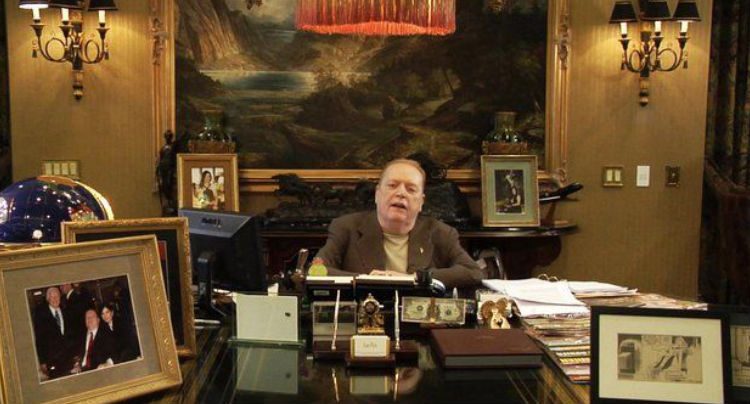
Though not a gripping film, it at the very least preserves Hustler's legacy for future generations to discover.

Though not a gripping film, it at the very least preserves Hustler's legacy for future generations to discover.
First-time filmmaker Michael Lee Nirenberg interviews his father, Bill Nirenberg, in his new documentary, but fuzzy sentimentality and paternal adoration plays little to no part in their on-camera conversation. Michael’s father was, after all, a “pornographer”, as he so gingerly puts it in the film’s early minutes. For many years, Bill was the art director at Hustler magazine, a publication known for sensationalizing pubic hair, putting women through meat grinders, the most vulgar satire you’ll ever see on paper, and, above all else, its ballsy (pun intended), unapologetic founder and mastermind, the notorious Larry Flynt. Back Issues: The Hustler Magazine Story is a brisk chronicling of the magazine’s history, from Flynt’s infamous antics to behind the scenes stories from staff members like Michael’s dad.
“Anyone can be a Playboy and have a Penthouse, but it takes a man to be a Hustler.” These were the now legendary words scrolled across the first edition of Hustler, an emphatic middle finger to the raunchy mag’s more proper competitors. This spirit of aggressive journalism (and full-frontal naughty bits) carried on throughout the years and defined the magazine and Larry’s attitude. Nirenberg’s presentation of Hustler’s history reflects the magazine’s anti-establishment aura, setting the nimbly cut archival photos and footage to raucous rock songs. The speed of the storytelling is to the film’s detriment, however, as the film often darts to the next topic just as the current one begins to get interesting. More time to marinate in the after-effects of Larry’s most outrageous scandals, especially the effects on his psyche, would have been welcome.

The film’s accelerated pace may be a consequence of Nirenberg’s misguided focus on he and his father. The elder Nirenberg’s stories about his time working for Mr. Flynt, while are at best mildly entertaining, and as an on-screen subject he leaves a lot to be desired. Nirenberg even puts himself in the shot with his dad on occasion, and while it may suggest some sort of generational intrigue, it ultimately leads nowhere. Often, the two look bored, as if they don’t know what to say next.
The other interviews included in the doc are excellent. Key anecdotes come from Flynt himself (in his signature late-life croak), his co-founder, Jimmy Flynt, and a stirring interview with Larry’s would-be assassin, Joseph Paul Franklin, prior to his execution this past November, who outlines in detail how he shot Larry twice for printing interracial pictures in the magazine. Former Hustler employees Chris Gore, Allan MacDonell, and Paul Krassner talk about producing what they called “lawsuit-quality work”, filling each issue of the publication with the crazy-provocative images we all know and love/loathe. Rounding out the talking heads are adult stars Nina Hartley and Ron Jeremy, who lend insight and…experience…to the production.
The rebellious philosophy that fueled Hustler is represented in well-crafted sections that illustrate what made the publication special. Instead of working with mainstream advertisers, Larry would instead run parody ads, attacking the big companies viciously. An anti-Toyota ad read: “From those nice people who brought you Pearl Harbor.” One of the magazine’s most famous covers depicts an attracted woman being fed through a meat grinder, a statement largely misunderstood by most consumers as misogynistic. Flynt’s brand of extreme Americana kicked the country in the teeth with every issue, but his anarchist message extended beyond the pages of the magazine. He went through a born-again Christian phase that ruffled more than a few feathers, and even ran for president, though he admits to being bipolar and doing it for the excitement of the campaign.
The way Nirenberg shoots the interviews is awkwardly off-center, literally. At times, his subjects are framed so small and off to the side that they cease to be the main focus of the shot. His compositions are endlessly distracting, and it’s unclear whether they were ill-conceived stylistic choices or technical flubs.
While the information, sound bites, and interviews Nirenberg presents in Back Issues are extensive and often eye-opening, the package in which it’s delivered is shoddy and rushed. Flynt is clearly the most intriguing piece of the greater Hustler story, but one can’t help but feel we only get to view him from a distance here, despite several revealing clips of the man himself. The film ends on a semi-somber note, with the interviewees mourning the death of print adult journalism at the hands of the internet and its trashy, mindless pornography. Hustler was a shining example of the 1st amendment in all its glory, and at the very least, Back Issues preserves its legacy for future generations to discover.